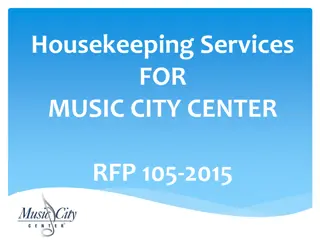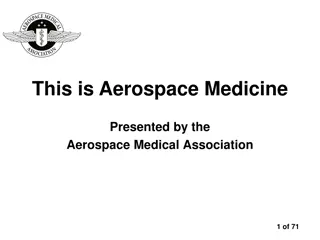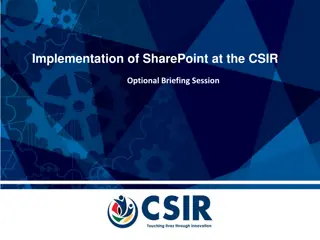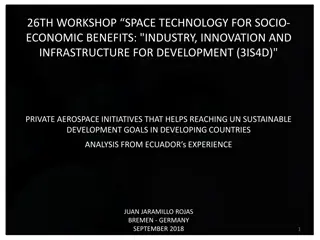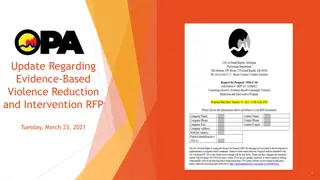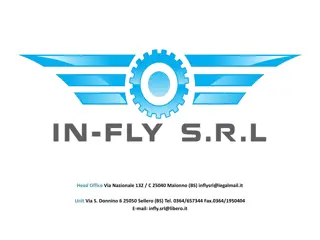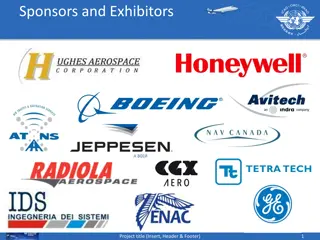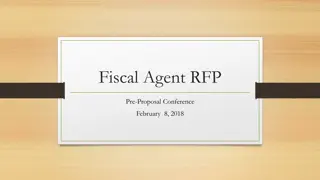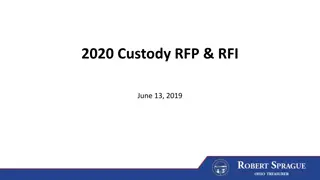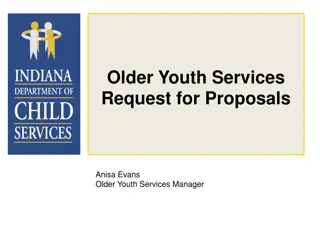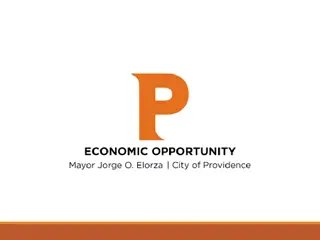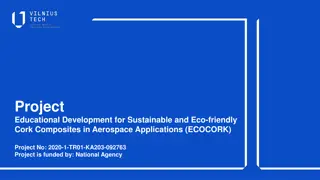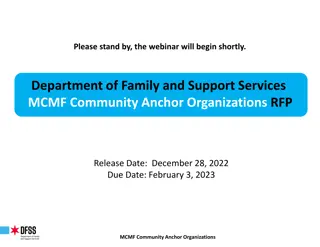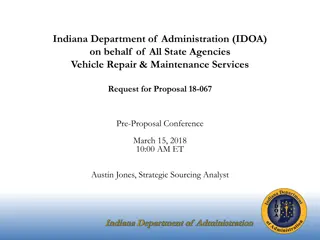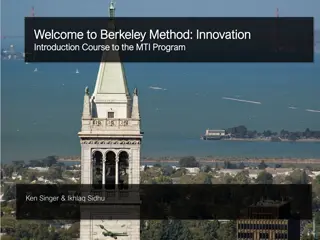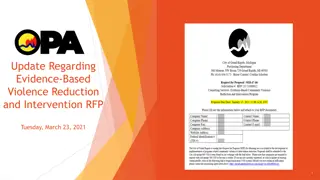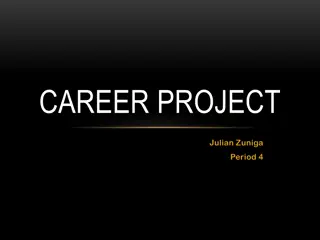2024 JCATI RFP Best Practices for Aerospace Industry Innovation
JCATI, a program mandated by WA legislature, facilitates collaboration between aerospace companies and public universities to drive technological innovation. Companies identify pain points, partner with academic experts, and receive funding to transition technologies. The timeline for the RFP process leading to project implementation is outlined. A clear emphasis on concise project abstracts is highlighted to ensure effective communication of objectives to reviewers.
Download Presentation

Please find below an Image/Link to download the presentation.
The content on the website is provided AS IS for your information and personal use only. It may not be sold, licensed, or shared on other websites without obtaining consent from the author. Download presentation by click this link. If you encounter any issues during the download, it is possible that the publisher has removed the file from their server.
E N D
Presentation Transcript
2024 JCATI RFP Best Practices
JCATIs Legislative Mandate Help WA aerospace companies transition new technologies by leveraging WA public university engineering expertise **Primary aerospace industry partner must have a WA presence ** Majority of project work and impact must occur in WA The WA legislature annually monitors JCATI s progress via metrics and reports. The expected ROI comes from industry incorporating cutting edge ideas from JCATI projects. This academic-industry interaction keeps WA competitive in the global aerospace market.
How does JCATI work? WA aerospace company identifies current TRL 4-7 technology pain point Company identifies potential WA public university engineering faculty with appropriate technology expertise Partners discuss technology need and determine if they are a match Academic partner submits a project application (with industry partner input) and if chosen, receives JCATI funds to support engineering students to address industry pain point Industry required to provide in-kind support to foster successful outcomes and company integration Goal: completely transition technology to industry partner 1 year or less after JCATI funding ends
2024 JCATI RFP Timeline RFP released: November 2023 Applications due by: 5 PM Friday, March 1 Applications sent out to reviewers: March and April JCATI board selection meeting: May Award notification: May Project period is 1 year o Project start: July 1, 2024 o Project end: June 30, 2025 Project final report due: July 18, 2025 All funds must be spent by June 30, 2025. No cost extensions are not allowed, and unspent funds are returned to the state through the UW.
Non-Technical Abstract Clearly and succinctly state the project objectives, deliverables and impact in 150 words or less. No figures! **Most common reviewer complaint: I can t tell what problem they are solving!** DO: Keep it simple and short. Specific details are for the narrative Make it clear. If a non-scientist read the abstract, could they identify the pain point? Put yourself in reviewer s shoes-do they know what to expect moving forward? DON T: Be vague: we will work on an important industry problem , we will help industry meet their goals Be super granular-specific details go in the proposal Be hyper technical or rely on acronyms Use a previous grant or manuscript abstract
Narrative Section A: Technical Merit and Project Feasibility A.1. Technical Background and Approach Clearly describe your industry partner s pain point and technology need. Expand on the abstract, providing technical details to the problem. State the current TRL level and why it was chosen. Describe how the academic partner s expertise addresses the technology issue. Explain how the proposed innovation affects the industry partner s manufacturing processes and/or market. If the project is a continuation from a previous year, explain why another year of funding is needed DO: Build off the abstract to fill in the pain point technical details. If helpful, include graphs/diagrams/pictures Clearly state the industry partner issue and technology gap Explain why your lab can successfully address the problem. Why is the company partnering with you to solve this problem? Be honest with your TRL level. TRL level descriptions are provided.
Narrative Section A: Technical Merit and Project Feasibility A.1. Technical Background and Approach DON T: Provide a long historical overview of the technology sector or industry partner Discuss your own research needs or career history Inflate your TRL level Be vague about the industry problem or technology need Copy and insert sections from your NSF grant Extensively mention previous unrelated projects or funding NOTE: limit of 2 pages total for sections A.1.-A.2. Wisely use this space to explain why this JCATI project is important and why you are the one to tackle it! Remember: it s not about you, it s about solving a problem for your industry partner The focus is applying your research expertise to solve a real-world problem in the funding period
Narrative Section A.2. Objectives, Outcomes, Deliverables Clearly list specific project objectives and deliverables as required by the industry partner. How will you solve your industry partner s technology problem? DO: Be specific: what technique(s) or equipment will you use to address the pain point and how will you do it? Use bullet points, bolding, diagrams or figures to make project deliverables clear Get technical! This is the place for details DON T: Say we will help solve the issues around this problem Say we will work with the company to address issues Propose solutions beyond the project scope Propose solutions that don t address the pain point
Summary: Technical Merit and Feasibility Did you provide a clear project description? Is the industry partner pain point clearly outlined? Did you explain how your lab will address the technology challenge? Did you explain why you are the appropriate academic partner? This section should provide the reviewer with a coherent understanding of the technology issue and how you will solve it
Narrative Section B. Industry Partner and Transition B.1. Industry Partner Support List the cash value and industry partner support type. Support can be materials, consulting time, machine time, cash, etc. This support must be sufficient to address the pain point. DO: List dollar amounts and breakdown of services (for example, $10,000 for consulting and $15,000 in materials for a total of $25,000) Check that amounts in the narrative and the letter of support match DON T: Use vague language: company will provide support as needed Say details are in the industry letter of support Omit the industry support
B.2. Partners and Roles Describe how each partner will manage their part of the project Faculty: how will you contribute to project success? Student involvement, timeline adherence, budget, etc. Industry: how will you contribute to project success? Provide necessary data, project meetings, validation, factory visits, tech staff involvement, etc. DO: Make it clear how both partners will interact for project success If helpful, use diagrams to show relationships and responsibilities DON T: Be vague: transition will occur at the end of the project Leave the transition responsibility to just one partner Say we will work with our industry partners to transition the technology
B.3. Technology Transition Plan Provide a project plan and/or timeline written with the industry partner. How will the deliverables in Section A.2. move from the academic lab completely back to the industry partner ideally within 1 year of JCATI funding ending? DO: List milestones to match the deliverables Use a timeline or chart to illustrate the transition Use figures if appropriate DON T: Be vague: we will share results with our industry partners Say the transition will happen in 5 years Ignore providing a plan Say at project end the technology will move to the industry partner without details
Summary: Industry Partner and Transition Section Is the industry partner s in-kind contribution clearly stated? Is the information in the industry letter consistent with the narrative? Did you explain how academic lab s results move to the industry partner? Did you explain each partner s role for achieving project success? Is everyone on board with the transition plan? After reading this section, the reviewer should have a clear understanding of the project partnership and technology transition for industry use
Narrative Section C. WA Economic and Educational Impact C.1. Business Opportunities and Job Impact Describe how solving the pain point benefits the industry partner? Include any measurable job creation or fiscal benefits. Is there a WA business opportunity the technology opens or improves? DO: Include any potential spinoff or jobs creation information Include relevant company information: expansion, new market, upcoming projects Include SBIR info if relevant to this project Tell us if industry partner is a startup company DON T: Say you will apply for SBIR or other business grants if you don t intend to Say the technology will create thousands of jobs without examples Say the technology will make a difference for WA aerospace without examples Inflate the market impact of the technology
Narrative Section C.2. Educational, Internship and Job Opportunities Describe how the JCATI project benefits WA public university engineering students. DO: Include real opportunities for industry student internships or mentoring Include specific industry interactions scheduled during the project Include any outreach interactions if known DON T: Inflate company internship or mentoring opportunities Say you will involve students and not provide a plan
Summary: Educational, Internship and Job Opportunities Section Have you explained how the project helps the industry partner? Overall WA aerospace community? Have you explained how WA engineering students benefit from participating in this project? After reading this section, the reviewer should have a clear understanding of the project impact on both the WA aerospace industry, the industry partner and engineering students
OPTIONAL Section D: Undergraduate Scholars Program You can apply for an additional $5000 to specifically involve undergraduates, including historically underrepresented groups. The funds must pay for meaningful, hands-on undergrad research experience with your project. The USP is optional as not every PI has the project space or bandwidth to add more students. Do: Describe your student recruitment and selection process Describe how you will specifically involve USP students in your project Don t Use USP funds for something other than undergrads. We specifically collect USP metrics as part of the project final report.
Narrative Section IV. References and Reviewer Suggestions If you have references from Sections A-C, add them here If you have names of potential reviewers, add them here If neither applies, skip this section DO: First check if your potential reviewer can participate in external review. Many companies do not allow this. Provide recent reviewer contact information DON T: Provide a name without contact information Provide a name without first checking with the person List your industry partner or industry sponsored research contact as a reviewer
Section V. Industry Letters of Support Each industry partner is required to provide a letter of support (LOS) verifying their project support and involvement DO: Request the industry LOS early as companies require multiple levels of approval Make sure in-kind amount in the letter matches the amount listed in Section B.1. Identify an industry point of contact in case of questions DON T: Wait until the last minute to ask for a letter of support Submit generic letters we will support the JCATI project NOTE: at project end the industry partner must verify delivered in-kind support amount
Section VI. Biosketch DO: Limit biosketch to 2 pages Use RFP format Include information pertinent to JCATI project DON T: Submit your entire CV Submit an unedited biosketch
Section VII. Project Budget and Justification Work with your departmental grants team on your JCATI budget DO: Make sure total tenure track faculty FTE doesn t exceed 1.0 month Include brief details for each category in the Budget Justification Include an equipment price quote and description in the justification Describe in the narrative why the requested equipment is necessary for project success Make sure the budget page is signed DON T: Pad your budget with excessive travel or supplies funds. Any unspent funds must be returned to the UW. Plan on using JCATI funds for foreign travel Skip budget approval process Wait until the last minute to ask for budget help-fiscal staff do not appreciate this
Submitting Your Proposal DO: Go to the submission portal and review the online form before upload Complete the proposal cover sheet and get appropriate signatures Assemble sections into one PDF for upload. Do you have the correct version? Done a final proofreading? Check you under the 4 MB file size limit Determine who submits the proposal: you? Grant manager? Student? DON T: Wait until the last minute to submit. Proposals are time stamped upon receipt in the system, not when you upload! There is always a lag. Email your proposal to the Program Manager. Only proposals submitted via the JCATI website are reviewed Ask the Program Manager if everything looks ok. We don t provide proposal input or notify applicants of missing sections. NOTE: The JCATI website creates an automated email acknowledging proposal submission. Additionally, the Program Manager notifies every PI as the database receives and time stamps the application.
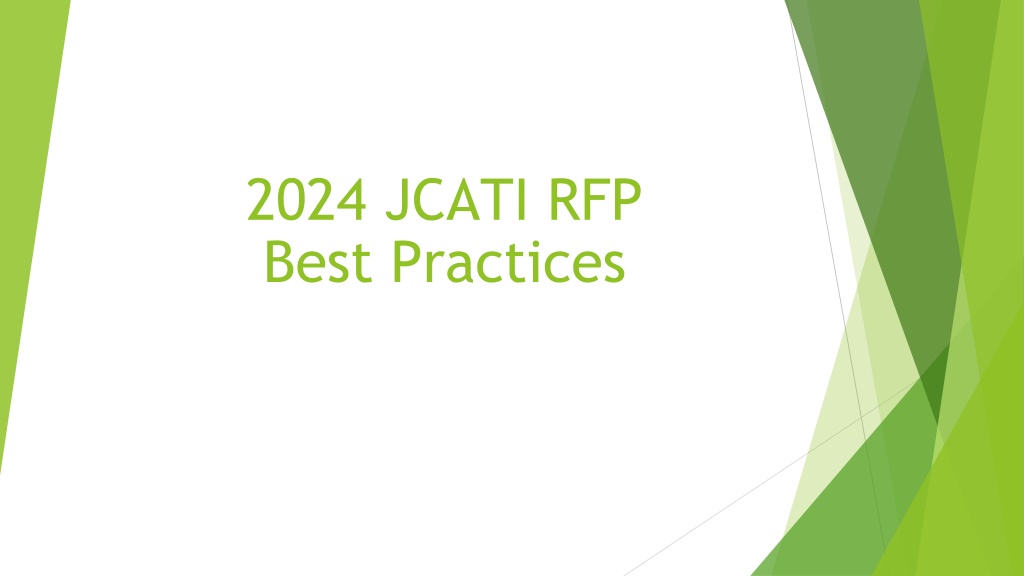
 undefined
undefined




